The Yamuna river has a long-standing history with the inhabitants of Delhi. The city developed around the river, it served as a source of water, and its floodplains became both a home and a source of livelihood for marginalised communities.
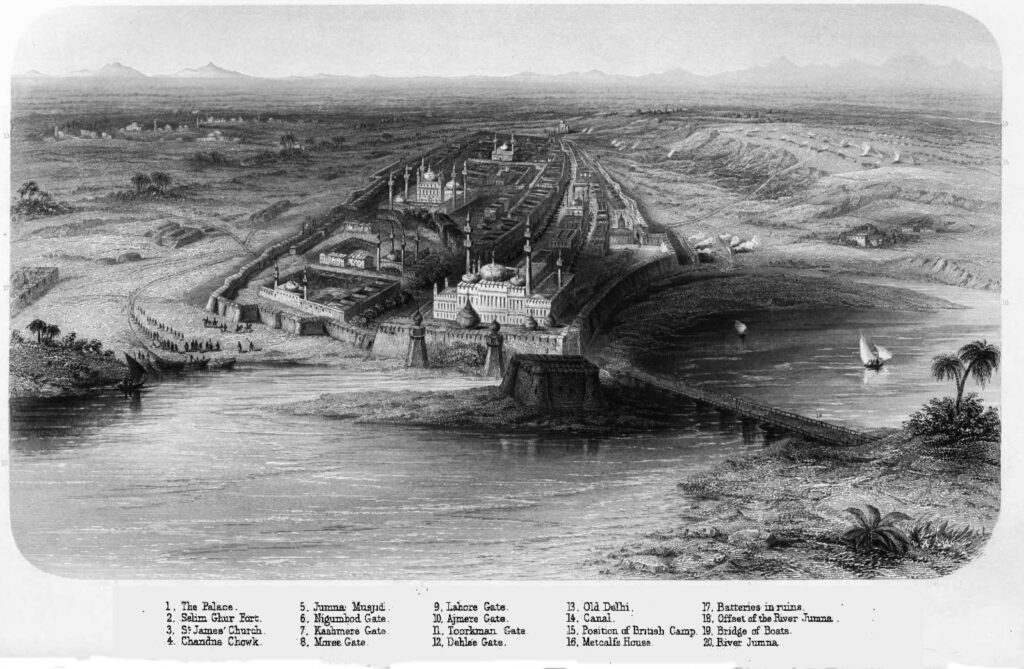
Today, the river is no longer a river. Its waters stand polluted and lifeless.
Over the years, beginning from 2015 up until 2020, NGT orders have pushed for the eviction of the urban poor from the Yamuna’s floodplains, as well as the removal of agricultural activities. All of this is done to ‘rejuvenate’ the Yamuna and protect it from the ‘pollution’ such settlements generate.
Such orders fail to acknowledge the contested nature of the floodplains—and the fact that its residents have hardly contributed to the river’s decline.
Crores have been spent by various state governments on different policies to ‘develop’ the Yamuna and bring it back to life. In the process, such schemes disenfranchise those communities that have lived by the river for generations. As ‘encroachers’ are evicted to ‘beautify’ the riverbank under different development initiatives, ultimately, the Yamuna remains as polluted as ever.
⼮
Flowing along the east of Delhi, the Yamuna enters the city from Palla village, making its way down into the urban sprawl. As it does so, the topography of its floodplains changes too, shifting from farmland, to slums, to permanent structures, to colonies. The waters between Palla and the Wazirabad barrage are relatively cleaner, supporting aquatic life. This is where Delhi’s fisherfolk also reside.
Yet, as the river passes through Delhi, it becomes more and more polluted: untreated sewage, industrial effluents, and construction debris are dumped in and around the Yamuna. The dissolved oxygen (DO) in the river’s water—which helps determine whether the waters can support aquatic life or not—falls within the standard range (or higher than 6 mg/L) only at Palla. It reaches almost 0 as the Yamuna exits Delhi at Okhla. The Biochemical Oxygen Demand (BOD) levels—which measure “the amount of oxygen consumed by bacteria and other microorganisms while they decompose organic matter”—are as high as 57 mg/L (with the standard range being less than 2 mg/l) when the Shahadra and Najafgarh drains join the Yamuna. This indicates their huge contribution to the pollution in the Yamuna.
With respect to such indicators, there has been no change in the water quality of the Yamuna over the years. Tons of untreated sewage and industrial effluents are still dumped in the river on a daily basis, contributing to 76% of the Yamuna’s total pollution.
⼮
To tackle the worsening pollution of the Yamuna, many ‘beautification’ and cleanliness drives have been launched over the years, most of which aim for the removal of bastis, or informal settlements, from the floodplains. The State rationale is that these settlements are polluting the river.
Beginning with the 2003 High Court order for the removal of all “unauthorised” structures from the floodplains, the Yamuna Pushta demolitions in 2004 were a mass State drive to wipe the urban poor from the city before the 2010 Commonwealth Games. Around two lakh people were uprooted from their homes, mostly without compensation and/or resettlement. Some were resettled on the outskirts of Delhi, to areas lacking infrastructure or public transportation facilities to their places of work. Meanwhile, other concretised structures like the Akshardham Temple and the Commonwealth Games Village continue to exist on the floodplains—both occupy more space than the bastis and use up far more groundwater.
The irony of this is that many of the displaced encroachers are the original inhabitants of this land in East Delhi, and have been farming for generations. Many also have land documents dating back to pre-independence India, revealing that they were taxed for their agricultural land. The earliest written account confirming the presence of agriculture here dates back to 1949, when the Delhi Improvement Trust and later the DDA granted the Delhi Peasants’ Cooperative Multipurpose Society (DPCMS) a short term lease of five years to cultivate on the riverbed.
Yet, they remain at the mercy of the Delhi Development Authority (DDA)—a state authority launched in 1957 to spearhead the city’s urban planning and development—to determine when and where farming is allowed in these lands.
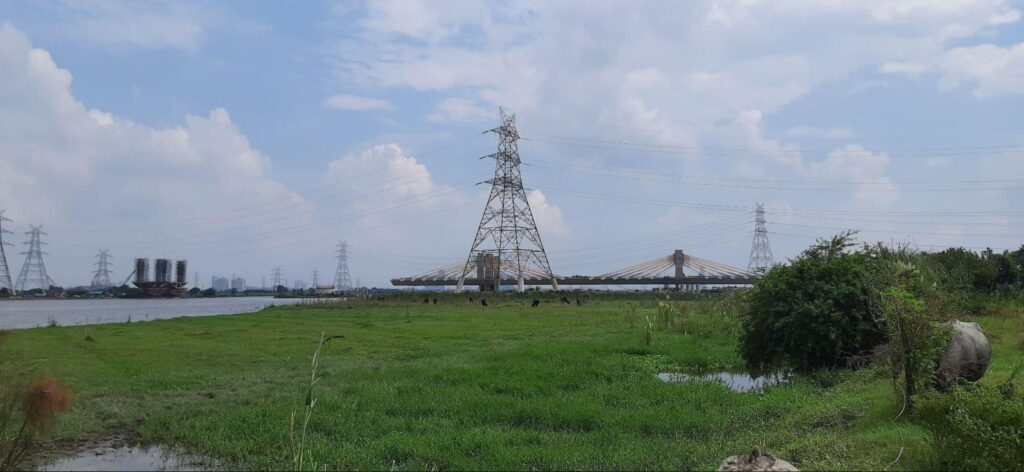
During field visits conducted by the People’s Resource Centre (PRC), a farmer in the Chilla Khadar told us that most farmers in this region belong to Mallah and Maurya castes. They originally hail from Uttar Pradesh, Bihar, Jharkhand, and West Bengal, and moved here with their families decades ago. They live in kacha, or unfinished houses near the land they cultivate, while many of their family members also work in the upscale residential colonies of Mayur Vihar.
Well aware of the uncertainty of farming in the khadar region, or floodplains, with a sense of resignation the farmer added, “we are ready to vacate the lands. We just want agricultural land elsewhere to continue the practice of farming.” Another farmer explained, “it is not wise to get attached to the land. If not today, tomorrow farming on these lands will come to an end.”
⼮
The farmer’s statements come off the back of certain peculiar development policy decisions made of late. Over the years, the National Green Tribunal (NGT) has pushed for the removal of agriculture from the floodplains by citing reasons of public health and “larger public interest”.
Manoj Misra, convenor of the Yamuna Jiye Abhiyan, explains the rationale behind the 2015 NGT order. “The NGT does not say that farming should be stopped,” Misra says. “It does say, however, that the kind of agriculture taking place on the floodplains should be stopped as it is a health risk, due to the poor water quality of the river. Instead, floriculture and horticulture can be practised.”
However, such judgements belie an important reality here: that farming is not necessarily dangerous or polluting, and certainly not at the same scale as untreated sewage or industrial effluents are.
In 2018, upon an NGT order, the Yamuna Monitoring Committee (YMC) was formed to monitor and report on the Yamuna’s pollution levels, as well as the sources of it. In one of its directives, the YMC asked the Central Pollution Control Board (CPCB) to test for heavy metal contamination in groundwater, vegetables, and fodder cultivated and used by farmers here. In their online report released in August of 2019, the CPCB reported no exceedance of major contaminants beyond the permissible limits.
Despite these findings, the YMC, in its fifth report published in December of 2020, still recommended a blanket ban on agricultural activities in the Yamuna floodplains. It also asked the DDA to expedite the eviction of farmers citing the NGT’s orders of not allowing any agricultural activity on the floodplains that use chemicals and fertilizers.
In Chilla Khadar, no farmer directly uses the Yamuna’s water for irrigation. Some have built bore wells at their own expense, while others use hand pumps. “Even we consume the vegetables that we grow. Everyone consumes the same produce here. How many people do you see in the hospital who are sick due to this?” questions a farmer from Chilla Khadar, when asked about the DDA’s claims of contaminated produce being cultivated here. “Earlier the Yamuna waters used to be clean. Now that the water is so contaminated we do not use it for irrigation at all.”
⼮
The eviction drives are puzzling in light of the various other development initiatives taking place on the floodplains. In 2012, a renewed State interest in the revival of the Yamuna began with a public interest litigation (PIL) filed in the National Green Tribunal. As per the NGT’s orders in the case of Manoj Mishra v/s Union of India & Others, an Expert Committee was formed to examine the issue of “solid waste pollution, the Riverfront Development Scheme of Delhi Development Authority (DDA) and the restoration, preservation and beautification of the river Yamuna.”
In its recommendation, the Committee warned against any construction on the floodplains noting that the area proposed for the Yamuna Riverfront Development (YRFD) Plan is within the active floodplains—or inside the embankments which are flooded frequently—and would affect the topography and flood-carrying capacity of the khadar, while increasing their pollution. Under the YRFD, DDA proposes to develop the stretch of the Yamuna for “recreational” activities, public facilities, and biodiversity parks.
Taking note of the Expert Committee’s recommendations and even the DDA’s 2013 public notice that mentioned that the YRFD should lie outside the river’s embankments, the NGT requested that no development activity take place within the River Zone.
Yet, despite these recommendations, a 22 kilometre stretch of the floodplains from Wazirabad to Okhla Barrage is being actively subjected to development activity under the Yamuna Riverfront Development Project.
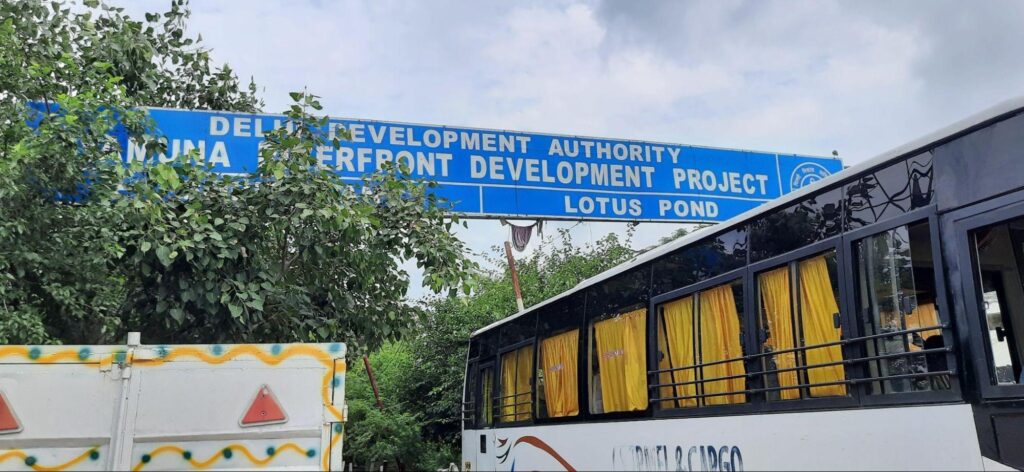
Upon PRC’s visits in September to November of 2021, we found that since November of 2020, the construction of water bodies, walkways, and cycling tracks were taking place on the floodplains. As per the recommendations of the Expert Committee, such topographic changes caused by ‘development’ here, especially the concretization of the floodplains, could aggravate flooding by reducing the flood-recharge area and increasing water pollution. The Committee also argued that the plans were unrealistic as they did not take into consideration the changing course of the river and may be eventually submerged.
These constructions, which lie on the active floodplains, were already partly submerged in water due to rains during PRC’s visits. Our team was informed that these ‘recreational’ areas might be opened up for commercial activity as well. There were a few settlements left in the area that would possibly be removed in the future too.
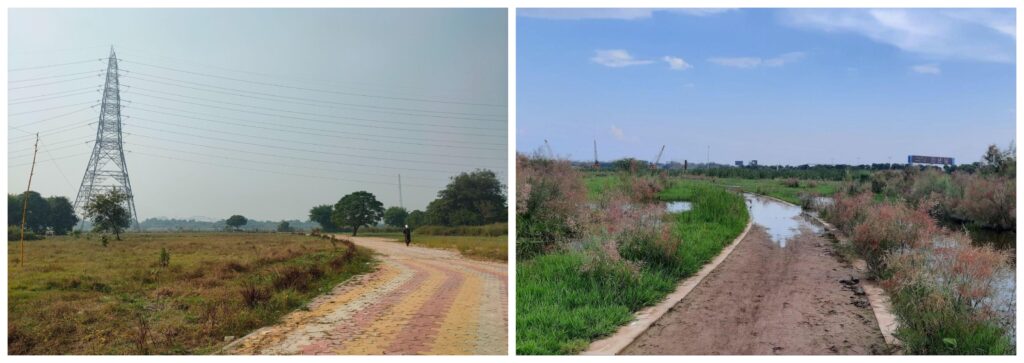
⼮
After reading about all these crores spent on development practices, one is then forced to ask: why is the Yamuna as polluted as ever?
Every year, massive amounts of foam collect on the surface of the Yamuna. This draws media attention, and once again a series of initiatives are launched by the government to clean the Yamuna.
In 2021, in supposedly yet another attempt to save the Yamuna, the YMC was dissolved, with the responsibility of implementing action plans handed over to the River Rejuvenation Committees (RRCs) of Delhi, Haryana, and Uttar Pradesh. At the same time, a Central Monitoring Committee headed by the Secretary of the Jal Shakti Ministry, which also includes the National Mission for Clean Ganga (NMCG) and CPCB, was also formed.
Sewage Treatment Plants (STPs), which to this day are dysfunctional and lead to vast amounts of untreated sewage being dumped in the river, found mention in almost every one of their plans.
Commenting on the problem of STPs, Manoj Misra argues that this issue is related to the processes of urbanisation. “This is not a river question,” he says. “Whether the river existed or not, a city needs a functional STP. The state of our STPs is a part of the urbanisation challenge. It is not related to the rejuvenation of the river. If the Yamuna flowed, it could have carried away any amount of sewage dumped in it.”
The issue is more to do with the many industries located on the banks of the river, and the non-operational STPs combined with the amount of sewage generated that exceeds the treatment capacity of operational STPs. The 2020 lockdowns led to the shutting down of these industries and reduced the extraction of river waters for usage across sectors, minimising the amount of untreated industrial effluents dumped into the river and spurring its flow. “The authorities fail to understand what the river wants,” adds Misra.
⼮
For decades now, the Yamuna and its floodplains have been home to communities that practise agriculture, look after the land and water, and help preserve biodiversity. However, because of their strategic, expansive location, the floodplains are vulnerable to destructive development and concretisation. This has undoubtedly caused irreparable damage to the floodplains and the river.
Even recent developments of creating ‘public spaces’ on the floodplains and increasing public access to the riverfront project have become ways to systematically deny the original inhabitants and urban poor living here to natural resources and dignified life. Resettlement ultimately expels them from the limits of the city.
“Even my house in Daryaganj was demolished,” recalls a guard working near the bastis on the Yamuna floodplains. “Despite having a pucca [fully built] house, I was not provided with any compensation. What hope is there for people who live in bastis then?” Farmers of Chilla Khadar revealed to us that after the demolition of their bastis for the construction of Akshardham and the Commonwealth Village, some people took shelter in Chilla Khadar, while others moved elsewhere. None were provided with any compensation.
Everywhere one goes in Yamuna Khadar, there is a sense of resignation in the voices of the farmers. They have accepted the reality that if not today, someday, they will have to give up their lands. Many are ready to move, clinging to the hope that they will be allowed to practice farming elsewhere in Delhi.
Inadvertently, the demolition drive and land usurping by the state seem to be doing more damage than restoration to the Yamuna and its surroundings. “The floodplains were always accessible,” surmises Misra, describing the riverfront project as an ornamental issue. “Those who want to visit can still visit and those who don’t want to, will not even after there is a riverfront.”
The historical trajectory of the efforts to rejuvenate the river Yamuna forces us to identify the linkages between environmental and social justice and question our understanding of urban development. It also reveals that the authorities have failed to understand what the Yamuna needs and have come to treat the symptoms of its disease of pollution, instead of addressing the root causes. For a better future for the river’, it remains important to acknowledge the benefits of what the government has obstinately overlooked—the relationship between the river and the indigenous communities inhabiting its floodplains.
The article has benefited from the contributions and inputs by Nishant, Geetanjali Gurlhosur and other members of the People’s Resource Centre.
Featured image: fishers paddle through the Yamuna’s polluted waters in Delhi; courtesy of Jyotirmoy Gupta on Unsplash.


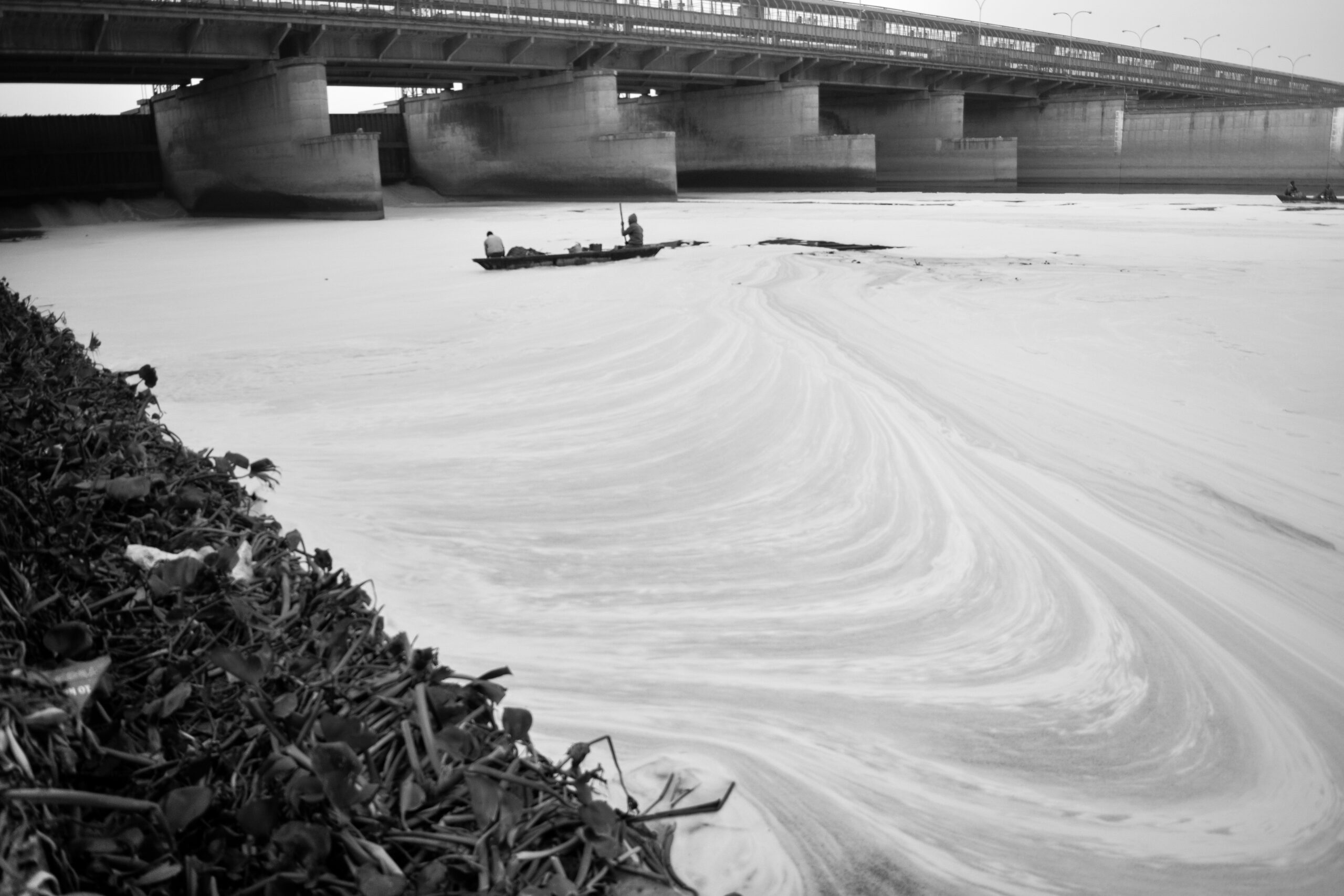
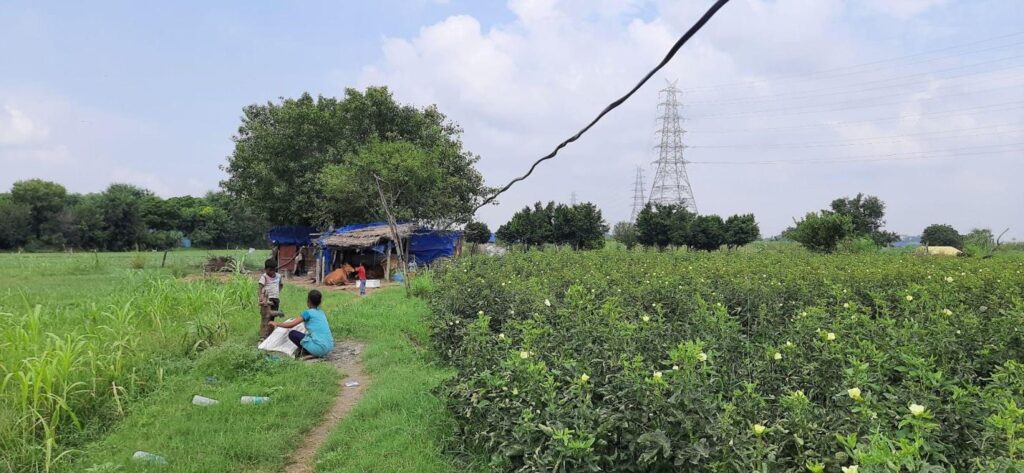




[…] Polluted river-yamuna […]
[…] [This article was originally published in The Bastion] […]